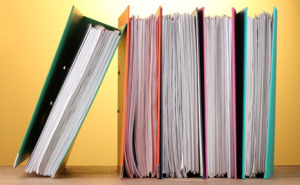Maintaining credentialing files can be a job in itself. I think it’s the way you approach it. Not unlike a challenging project or recipe, with good preparation, organization, and a little creativity, your credentialing files can be organized, up-to-date, and survey ready. Whether you are the one doing credentialing, or supervising those who do, here is my “recipe” for getting it done.
1. Review your “recipe”. Typically, your facility’s by-laws will outline your credentialing requirements, including re-appointment times and malpractice limits. Utilize this information, along with regulatory requirements determine what documents you will need.
2. Create a “shopping list” for your “supplies”. List any documents your files need. Indicate which need renewal, and check when complete. Indicate renewal dates, and keep updated for quick review. AAAHC now requires a new application with every re-appointment. Include a permission slip/waiver for applicant signature so you can run all your checks.
3. Gather the right tools for the job. Maintain a template as to how your files will be set up, and use as a resource for new files. I like segregating documents by appointment/re-appointment, privileges, licensure and verification, training and education, and health. For the health file, I place in a removable folder for confidentiality.
4. Go shopping. Prepare a request document and provide to your applicants that indicates everything they will need to provide. E-mail the document with attachments of facility documents they will need to complete, including confidentiality agreement, a Hepatitis B requisition/declination form, and any policies or documents they may need to review. Request attestation signatures as needed.
5. Put it all together. Once received, check it off the list and file. Remind the applicant of anything missing.
6. Check all your ingredients. Primary source verification has four ingredients on my list: A state license check, AMA, NPDB, and OIG. Run all the checks and print verifications. If you need web addresses, check out my “awesome resources” links.
7. Add the topping. Don’t forget to add the health file, training, and peer review. Get a health statement, current TB, Hep B form, current flu vaccination, provide flu vaccine and TB check if needed. AAAHC requires safety and infection control training specific to your facility for everyone. They can read your policy and attest completion.
8. Serve Complete. Now that your recipe is complete, bring it to the Governing Board for approval, and get a sign off. Make sure to include that peer review activities were part of the decision process. Note the outcome in your minutes, and notify your applicant of the result.
9. Keep your recipe updated. Utilize your Outlook calendar or other tools or apps to remind you when documents need renewal. I have started using the EasilyDo app as a reminder tool, and find it helpful. As far as your delineation of privileges list is concerned, make sure you update it with any new requested procedures and get GB approval as that happens. Don’t forget to include non-procedure privileges, like moderate sedation and radiology.
10. Try to keep it simple. Purge the unnecessary, and archive the old. The best recipes work when the process is simple, organized, and practiced.
I plan on making peach cobbler for a Sunday cookout from my grandmother’s recipe. I hope I follow my own advice.


